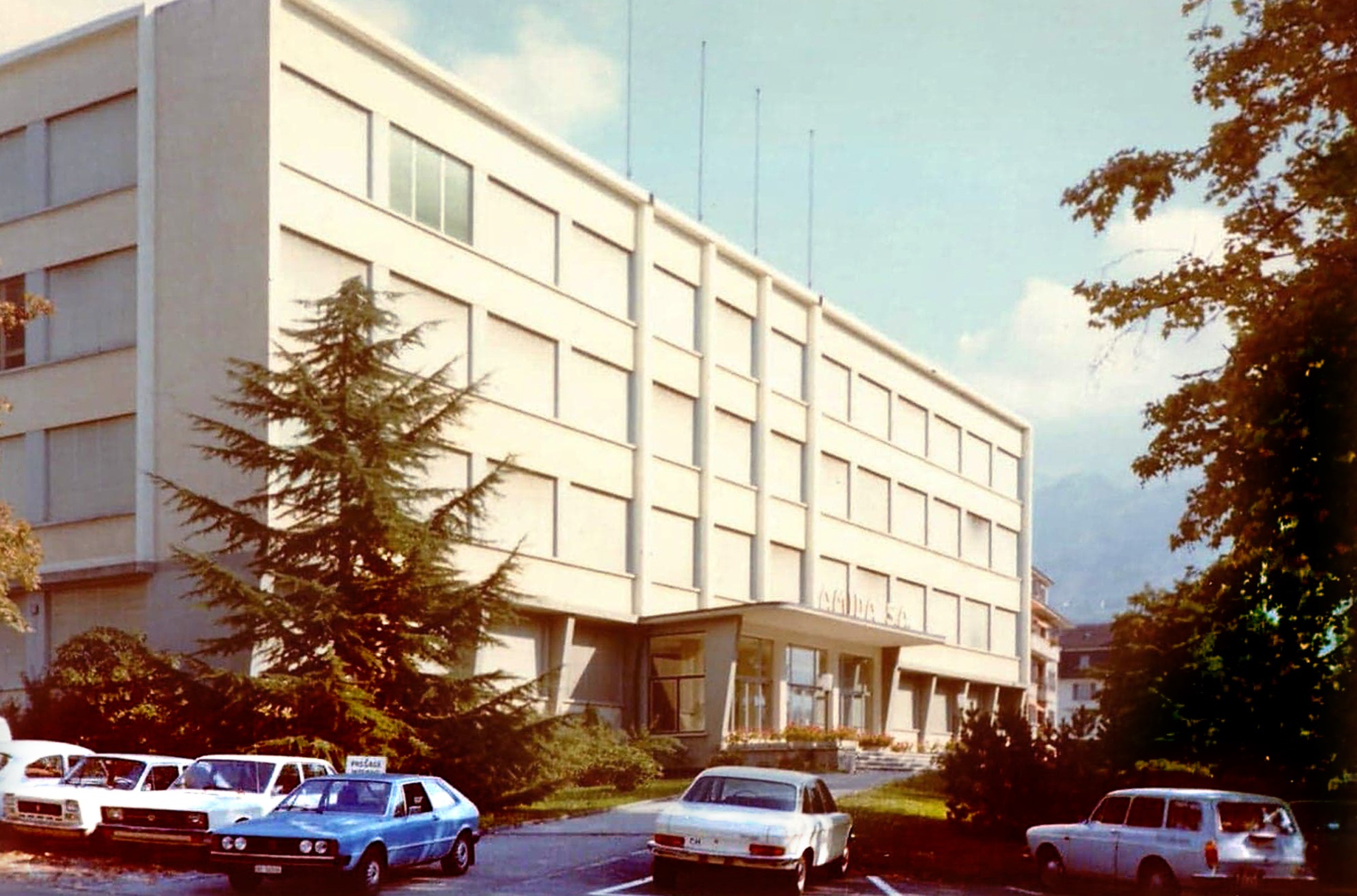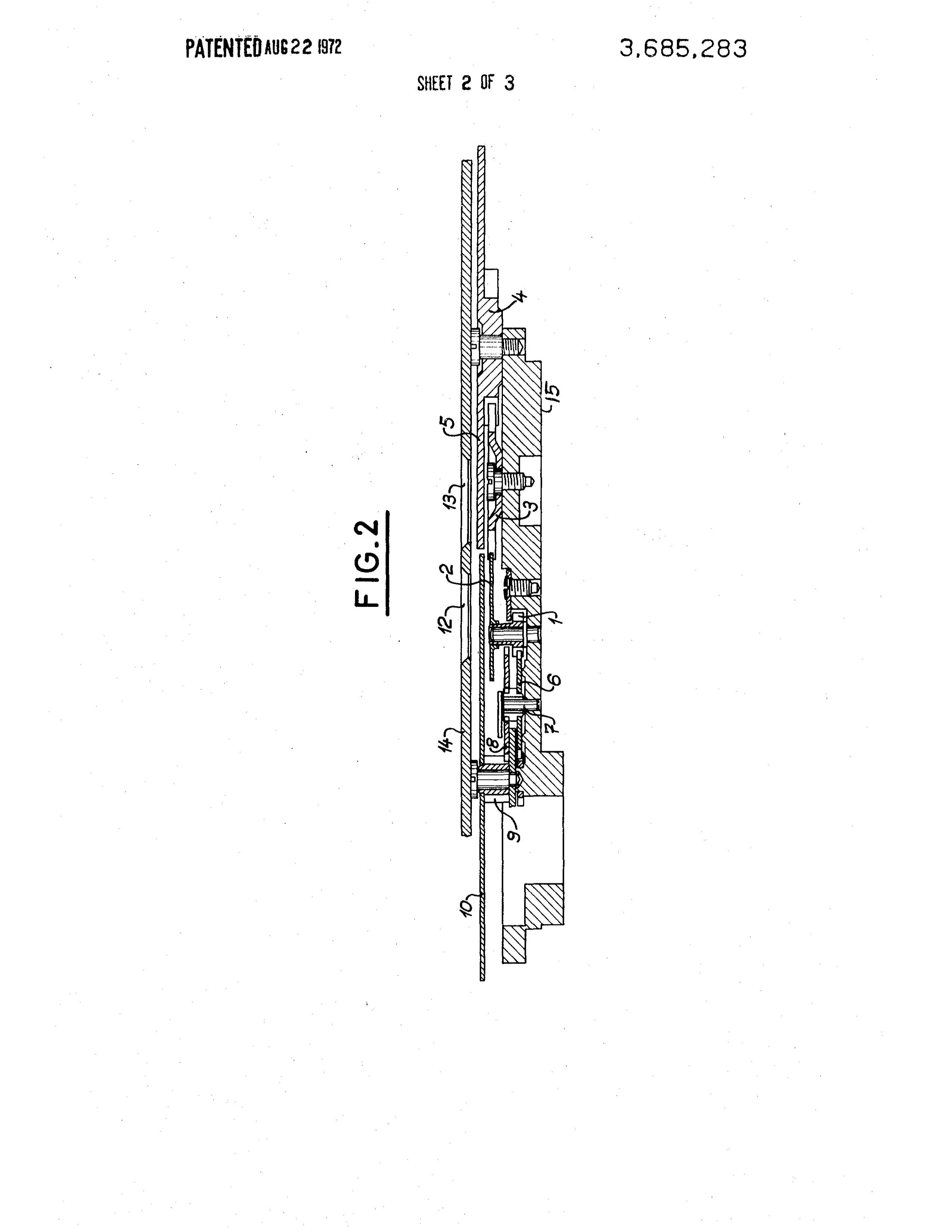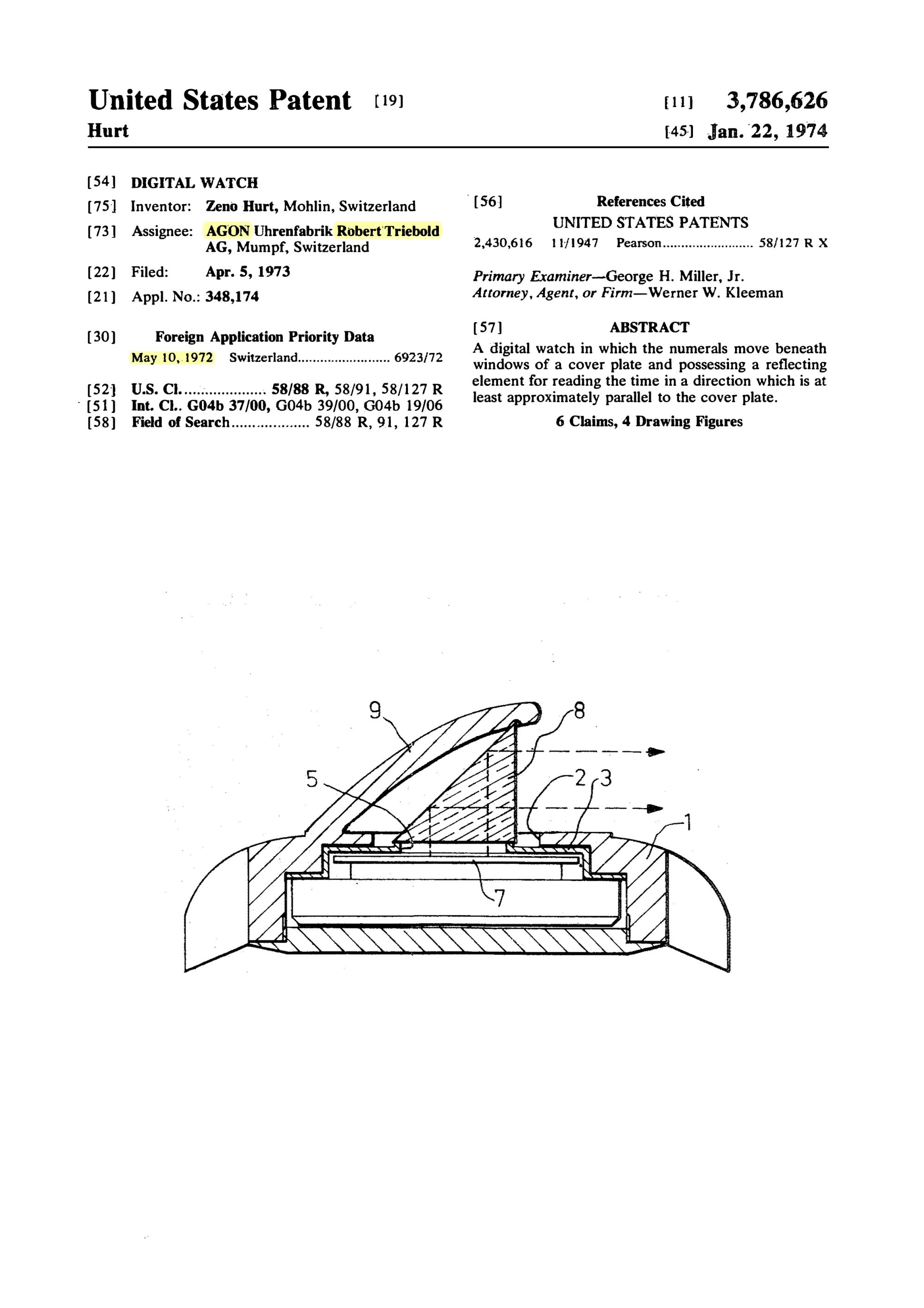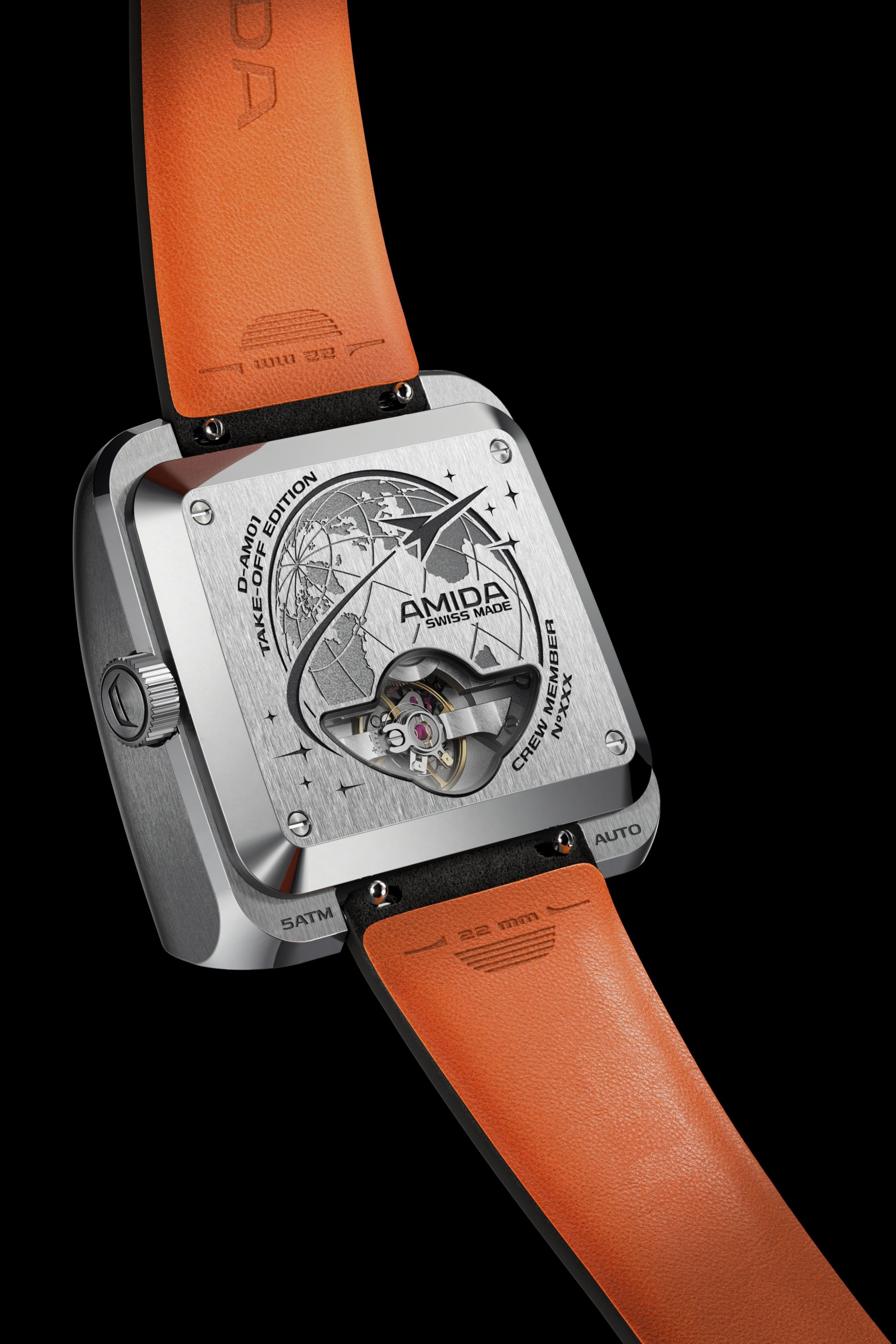AMIDA Digitrend Take-Off Edition
Tracing back to the origins of Swiss ‘digital’ timekeeping – AMIDA makes a grand comeback with a model that remains unforgettable: the famous DIGITREND driver’s watch.
Remember the AMIDA Digitrend? A true gem from Baselworld 1976. A Swiss watch with futuristic lines inspired by the sports car designs of the era, a hybrid before its time as it combined a mechanical movement and original LED-style display.
The Swiss brand, pioneer designer of the coolest digital watches of the 70s, marks its grand return on April 30, 2024.
A tribute to a magical decade, a toast to a future unfettered by creative diktats,
where ‘Space Age’, boundless enthusiasm and disruptive aesthetics are intertwined.
The iconic DIGITREND driver’s watch, with its retro-futuristic style, is reborn with more
refined finishes, an automatic movement equipped with a jumping hour module, a sapphire
prism for the side display, and a clear, precise ‘digital’ readout.
The shape? Unconventional to say the least. A vintage piece with a modern twist!
It’s been nearly fifty years since the AMIDA Digitrend was launched at Baselworld in 1976.
Iconic from the start, it symbolized the audacity of a whole generation and inspired
independent watchmaking from the 2000s to the present day.
On the eve of AMIDA’s 50th anniversary, two young entrepreneurs
from the watch industry (watch designer Matthieu Allègre and Clément Meynier, founder of
Depancel), are opening a new chapter for the brand with the re-issue of its flagship model.
This first collector's series, the “Take-off Edition", will be available
for a very limited pre-order period from May 28th, 2024.
“Together, we can go further” – watch enthusiasts across the spectrum will be able to
rediscover thanks to a hybrid distribution strategy that blends e-commerce and selective
distribution through a few chosen retailers. The co-founders are set to meet with enthusiasts
during a roadshow scheduled for May 2024, which will kick off in the U.S., make stops in
Asia, and conclude in the Middle East.
Made in the 70s
Dreams are cast into the future. The 1960s and 70s exemplified this like no other era. Then, the imaginable stretched beyond the horizon; the present was infused with the taste of tomorrow. The world was stepping into a new age, leaping towards modernity. Amidst a society in flux, buoyed by a future painted in idealistic strokes, creativity was ebullient everywhere. This complete renewal also manifested a new quest for meaning. “New needs need new techniques. And the modern artists have found new ways and new means of making their statements... the modern painter cannot express this age, the airplane, the atom bomb, the radio, in the old forms of the Renaissance or of any other past culture,” visionary painter Jackson Pollock had already observed in 1951. One thing was for certain: nothing would remain as it was. Creativity was now fully empowered by technology. The possibilities of computing and electronics were no longer just utopian dreams.
Progress for everyone
During this extraordinary era, major inventions would hasten the pace of progress across various fields, carrying the promise of a future both accessible to and shared by all. The positive changes would not be confined to a select few; they were poised to transform the daily lives of millions. Boldness and freedom were in the air, lighting up the world. The LED (light-emitting diode) emerged in 1962, followed by the first liquid crystal displays in 1964. Civil aviation, which had begun developing just decades before with companies like TWA (founded by none other than Howard Hughes) and the iconic Lockheed Constellation (which also served Pan Am), was already flying high in the jet age, marking an amazing milestone with the Concorde’s maiden flight in March 1969. This period also witnessed the rise of synthetic materials, creating new possibilities – and freedoms – in countless fields for millions of users. Take Kevlar, a synthetic fiber with outstanding properties that found its use in everything from spacecraft to kitchenware. The 60s and 70s were pivotal in the evolution of science and technology, ushering in countless innovations.
The promise of a more beautiful world
The 1960s and 70s stand out in modern society not only for their impact but also because they represented a promise: a generous commitment based on the idea of sharing progress for the benefit of all. Developments unfolded rapidly. In 1967, Professor Christiaan Barnard performed the first human heart transplant. That same year, over 50% of households owned a television set, and the technology was fast transitioning to color. In 1969, the introduction of quartz watches revolutionized the watchmaking industry. That same year, on July 21st, humanity took first steps on the Moon, opening a whole new frontier. The possibilities seemed endless.
The sky was no longer the limit
This promise of infinite possibilities spread through all realms of design, defining a new, futuristic aesthetic. With the release of Frank Herbert’s first novel, Dune, published in 1965 – a futuristic epic of amazing scope and prescience —science fiction got a tremendous boost, not only in the movies. Fashion designers were quick to embrace this inspiring theme as well. Pioneers like André Courrèges and Paco Rabanne led the way. “The garment I prefer is the one I invent for a life that does not yet exist, the world of tomorrow,” exclaimed Pierre Cardin.
When cars had wings
The automobile, too, underwent a transformation as radical as it was imaginative during the 1950s and 60s, inspired by the allure of space travel and technological advancements. Not only did aerodynamics play a crucial role, but safety features also evolved significantly. Cars adopted futuristic, aerodynamic designs, complete with wing-like fins – a testament to the era's fascination with aviation. At its Motorama exhibitions, General Motors unveiled its turbine engine–powered ‘Firebird’ concept cars.
Alfa Romeo's BAT (Berlina Aerodinamica Tecnica) series, initiated in 1952 under Nuccio Bertone, pushed aerodynamic design even further, marking a revolutionary approach to automotive design.
Inventing the shapes of the future
In the following decade, Bertone turned to another gifted young designer, Marcello Gandini, who defined the allure of the future with creations such as the Alfa Romeo Carabo (1968) and the Lancia Sibilo (1978), paving the way for iconic models like the Lamborghini Countach and the Lancia Stratos. The era was marked by wildly imaginative concept cars: the Ferrari 512S Modulo (1970) and the Maserati Boomerang (1972) are just two examples that showcase the unbridled futuristic creativity, akin to designing spacecraft for the open road – or turning them into submarines, like the famous Lotus Esprit ‘Wet Nellie’ that stole the show from James Bond in ‘The Spy Who Loved Me.’
The future is now!
The world was in the midst of the Space Age. One of the most significant manifestations of the widespread enthusiasm for the promise that the future held took shape in the bold architecture of time. The main terminal of Los Angeles International Airport inaugurated in 1961 resembled a structure fit for life on another planet with its curving, capsule-like shape and tall, spindly legs. The aesthetic breakaway from traditional tenets was radical total.
If technology and design also became inextricably linked in all facets of everyday life, this was most obvious in interior decoration, from hotels and shopping malls to offices and homes. Among the most remarkable achievements are the signatures creations of Matti Suuronen, John Lautner, Eero Saarinen and Charles and Ray Eames.
A new vision of design
An organic connection emerges between objects and their users. Verner Panton's creation, the ‘Panton Chair,’ represents a pivotal moment in design history as the first single-form, massproduced plastic chair. It embodies the concept of uniformity in form and material. This era's visual language, characterized by flexible, modular, and ergonomic materials, mirrors a modernity that is both transformed and transcendent, adapting to societal shifts and evolving lifestyles.
1976 – A year of tectonic shifts
In myriad ways, 1976 stands out as a watershed. Abba tops the charts with Money, Money Money; Rocky dominates global cinema screens. In This year witnesses significant shifts, including the profound transformation of the global economic system post-Jamaica Accords, leading to the demonetization of gold and the free-floating currency rights for all nations, diverging from the Bretton Woods system established in 1944. The Apple I, created by Steve Wozniak and Steve Jobs, heralds the personal computing era. Meanwhile, the Viking 1 and Viking 2 landers extend space exploration's frontiers by touching down on Mars, the first successful email is sent, and VHS emerges as the videotape format standard.
The AMIDA Revolution
That same year, 1976, an innovative watch, the Swiss watchmaking brand AMIDA unveils the Digitrend at the Basel Fair – causing a sensation.
Flashback. It’s April 24, 1976, and as you approach Booth 603 in Hall 1, an astonishing object, both androgynous and gender-neutral, immediately catches the eye. There is no dial. In its place, a display screen under a crystal, evoking the dashboard of a sports car or spacecraft controls. The case is far from conventional, too. Breaking away from usual formalism, structured and bold, it mimics the sleek lines of a road racer. The ergonomic design naturally wraps itself around the wrist. With its chrome-plated metal shell and matching wide-link bracelet, it is a bold departure from the norm, merging form with futuristic function.
Visually unmissable and unconventionally proportioned at a width of 39.8 mm, the watch sits perfectly on the wrist. Its vertical display, prized by drivers as it allowed for easy reading of the time without taking a hand off the wheel, positioned it as a quintessential ‘form follows function’ watch. Perfect for astronauts as well.
Made in the 70s
Defying expectations, the Digitrend doesn't rely on the then-popular electric or quartz movements, nor does its display stem from LED or LCD (liquid crystal display) technology. Embodying Swiss watchmaking's finest practices, the Digitrend features a manually wound mechanical movement, showcasing a blend of traditional craftsmanship and modern design.
Initially established in Grenchen in 1925 by Joseph Zwahlen and then relocated to Montreux by Ernest Triebold in 1949, AMIDA has continuously evolved. From the outset, the brand distinguished itself by embracing modernity and aligning with contemporary trends, notably adopting pin-lever or visible anchor movements with ‘Rosskopf’ escapements for affordability and competitiveness into the early 1970s. This approach enabled AMIDA to maintain relevance and appeal through changing times.
Jumping hours and optical illusion
For its spectacular Digitrend model, AMIDA opted for two movement types: a visible anchor movement (1 jewel) and a pin anchor movement (17 jewels), which together allowed for a jumping hour disc and a trailing minute disc (Patent No. 3,685,283 filed on November 13, 1970, by Joseph Bamat from La-Tour-de-Peilz in Switzerland; the same patent number that appears on the back of Digitrend watches). There is no luminous or electronic display. So what is the secret?
AMIDA’s idea is more than ingenious. The readout is actually an optical effect created by a crystal in the shape of a prism – think submarine periscope. The movement operates horizontally, but the ‘image’ of the hour and minute discs is projected vertically. AMIDA called its system LRD (for Light Reflecting Display), which was patented under No. 3,786,626 on April 5, 1973, by its inventor, Zeno Hurt, from Molhin, Switzerland, on behalf of Robert Triebold. A remarkable and singular proposition in horology that makes the Digitrend a watch truly ‘extra-ordinary.’
An inspiring success
The AMIDA Digitrend stood out as a timepiece perfectly aligned with its era, quickly achieving success. Despite competition from other futuristic, electronically-powered ‘cap-shaped’ watches, the Digitrend’s mechanical movement helped it become one of the most iconic ‘digital-display’ Space Watches. This fusion of traditional mechanics with a forward-looking design underscored its unique appeal in the watch industry.
Although AMIDA went bankrupt in 1979, the iconic Digitrend endured, directly inspiring Maximilian Büsser's first creations for MB&F, including the HM5, HMX, and HM8 models. This watch has stood the test of time as an ageless piece admired and coveted by enthusiasts and collectors alike.
2024: Digitrend ‘Take-Off Edition’ – the cool watch for modern times
Back to the future. 2024 marks the great comeback of AMIDA’s Digitrend: reimagined, refined, modernized and perfected through the deep commitment of enthusiast Matthieu Allègre, his partner Clément Meynier, and talented horological engineer Bruno Herbet.
A dream team at the controls
After honing his skills at design agencies throughout Switzerland and working at Piaget, Matthieu Allègre embarked on his entrepreneurial journey at just 27 years old in 2015, eager to explore his full creative potential. Within just a decade, Allègre collaborated with over fifty brands, including such prestigious Maisons as Louis Vuitton, Chopard, Jacob & Co, and Corum, showcasing his significant impact in the watch design industry.
Recently, he contributed to the creation of the Chronomètre Artisans alongside Simon Brette, a rising star in independent watchmaking, who was notably recognized at the GPHG 2023.
From his office in Geneva, Allègre coordinates and designs the watches for Lyrique, a venture led by Bill Sanders that brings together a hundred collectors around an Agenhor caliber, set in a case made by Voutilainen & Cattin SA. This project has gained prestigious status among Haute Horlogerie enthusiasts.
Clément Meynier enhances the team with his visionary entrepreneurship. As the founder of KOPPO and Depancel, and a lover of automobiles and design, his expertise in distribution and strategy is invaluable: “As an entrepreneur in the watchmaking world, it's an incredible opportunity for me to be able to relaunch a historic and pioneering brand – and one of the first to have this vision of a watch, not as a mere functional object, but as an object of art and mechanical design. What’s more, AMIDA inspired the vision of those who made me passionate about watchmaking, namely MB&F and Urwerk."
Bruno Herbet is the third key talent behind AMIDA's resurgence, tackling the project's technical challenges. As an engineer specializing in micro-mechanical watchmaking and a seasoned watchmaker in the Vallée de Joux, the cradle of Swiss watchmaking, Herbet has an impressive background with prestigious brands such as Jaeger-LeCoultre and Vacheron Constantin. He also served as the technical director for Orkos, a vibrant new brand, bringing a wealth of experience to the revitalization of AMIDA.
The Incredible Story of a Renaissance
Beyond a shared passion for watches, what led Matthieu Allègre and his partners to revive the AMIDA brand? Their story is truly remarkable. It began in 2015. A friend of Allègre’s had just acquired forty new old-stock AMIDA Digitrend watches at an auction. When he held one in his hands, it was a revelation for the watch and design enthusiast. Maximilian Büsser, recognizing their value, purchased one, which directly inspired the HM5 and kick-started the horological journey of MB&F. Great ideas are never lost.
I discovered AMIDA as a brand through a friend almost 10 years ago. I just fell in love with the Digitrend and its disruptive, retro-futuristic style. Then, as a designer, I immediately thought about the variety of possibilities this watch could offer, in terms of style but above all in terms of the obvious link with the automotive world. That was even before I realized that it had already inspired other independent brands. Later, as I delved into the brand’s history, I went from discovery to discovery, delighting in every clue like a researcher. Until it became an obsession,” shares Matthieu Allègre.
One aspect that resonated with Allègre is the watch’s strong identity. Not only because of its history, which runs parallel to the rise of quartz digital watches, and the rich narrative it presents. Aesthetically, too, it has distinctive personality that encapsulates an era, evoking a multitude of technical and socio-cultural references. And technically, its original display system demonstrates ingenuity. That was all it took to spark the watch designer’s ambition to launch a new project. For a time, he even contemplated creating a new brand from scratch.
Off to new horizons
One thing is for sure: for Matthieu Allègre, this somewhat – and undeservedly so – overlooked watch has been a serendipitous find. Drawing from its space-age inspiration and intrinsic ties to automotive design, the Digitrend’s case construction mirrors that of a sports car’s bodywork. This led to Allègre embarking on an initial project that blended the watch’s features with the brand universe of a renowned British sports car maker, and approaching a major Swiss watchmaking brand to get the idea off the ground. When the collaboration did not materialize, Allègre decided in 2022 to relaunch the brand himself, venturing into, for him uncharted territory.
Uniting energies with his infectious passion, Allègre, a determined perfectionist, brought all the stakeholders together to solve the legal hurdles, paving the way for AMIDA’s resurgence. In 2020, engineer and watchmaker Bruno Herbet, who had worked at Daniel Roth and Gérald Genta's workshops in the past, joined the venture. He was soon followed by Clément Meynier, a horology aficionado with a degree from the prestigious Paris Arts et Métiers engineering and research institute, who by then had founded KOPPO and Depancel. The trio’s diverse strengths would naturally coalesce in the revival project for this standout watch– and a new chapter began unfolding.
Better than a tool watch, a cool watch – for the new adventures of the 21st century
Though he didn’t have to start with a blank page, Matthieu Allègre did see value in aligning the watch with our time. While it preserves the essence of the model first introduced in 1976, the new AMIDA Digitrend ‘Take-Off Edition’ presents a number of improvements. The car body-style case, machined from a block of 316 L stainless steel, has seen its contours refined for sleeker aesthetics and improved finishes, enhancing its fluid profile. The subtly redesigned case, water-resistant to 50 meters, now has an open back, revealing the regulating organ of the mechanical self-winding movement – Soprod’s modern and reliable Newton caliber (23 jewels), which beats at 28,800 vibrations per hour (4 Hz) and offers 44 hours of power reserve.
Featuring an in-house developed module with a unique dual-disc construction of only 9 components, doubling as both a plate and a casing ring, this modern movement – with the tightest tolerances – incorporates jumping hours for exceptional efficiency and precision. Amplifying these technical improvements find themselves amplified by aesthetic refinements, like the redesigned minute window and completely redesigned typography – true to the original orange digits emblematic of the 70s. The logo, signed by typeface and graphic designer Johann Terrettaz whose credits include Urwerk and Akrivia, also took a leap through time. The supple and sensuous strap, combining calfskin and Alcantara, complements the watch’s overall eye-catching presence.
Online pre-orders – limited in time only
Opting for an AMIDA Digitrend is a statement of individuality. To acquire the new AMIDA Digitrend ‘Take-Off Edition’, enthusiasts must act fast during the exclusive preorder window from May 28, 2024. Although there is no limit to the quantity of watches, the short online preorder period of time is set in stone and exclusive to AMIDA's website. Deliveries will be scheduled for October 2024.
A hybrid distribution approach
As another original feature, AMIDA introduces a novel hybrid distribution method. It will be available for e-commerce on AMIDA’s website as well as through a handful of ambassadors chosen among the most selective and demanding retailers. These partners are at the forefront, making the market tick and supporting new creations, be it for their technical intricacy or their unique design, through their independence, experience and stature. These special relationships will pave the way for unique and personalized collaborations. Meanwhile, the brand’s online platform will ensure a seamless and swift purchasing experience, benefiting from the flexibility of its exclusive omnichannel distribution model.
‘Crew Member’ – Joining the AMIDA Adventure
Ultimately, choosing an AMIDA Digitrend means joining a special community of enthusiasts. It means embarking on a journey as a founding member of an informal, modern club dedicated to reviving this legendary model. Early buyers of the inaugural ‘Take-Off Edition’ will be made official Crew Members of AMIDA, marking their integral role at the heart of the project.
Technical specifications
AMIDA Digitrend Take-Off Edition
Case
- Material: 316L stainless steel, satin-brushed and polished
- Dimensions: Width: 39 mm / Length: 36 mm / Height: 15.6 mm
- Crystal: Sapphire crystal reflective prism
- Water-resistant to 5 ATM (50 meters)
Display
- Dual discs, for hours and minutes, respectively (LRD – Light Reflective Display)
Movement
- Soprod NEWTON P092, Swiss automatic mechanical winding
- Auxiliary Jumping hour disc developed in-house module with 9 mechanical components and 6 screws
- Number of jewels: 23
- Frequency: 28'800 vph (4 Hz)
- Power reserve of 44 hours
- Thickness: Movement : 4.6mm / Auxiliary module: 2mm
Finishes
- Finishes Côtes de Genève, sandblasted, circular-grained
- Skeletonized oscillating weight
- Rhodium-plated finishes
Strap and buckle
- Charcoal Alcantara lined in orange calfskin
- Lug width: 22mm
- Stainless steel buckle, 18mm
MSRP: CHF 2’900.- (excluded VAT)
For more information, please visit amida-watches.com


































Comments
Leave a comment